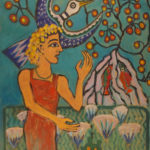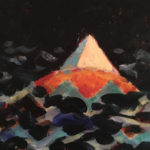Now we get into the crucial part of the Egyptian mythology, the story of rebellion and the death of Osiris. These are the stories of the children of Geb (Jeb) and Nut (Noot), the Earth and the sky. This story is about the good ‘god’ Osiris and introduces his evil, jealous brother Seth’s plan to overthrow Osiris and take control of the kingdom. It’s a theme common to many mythological or religious texts, the story of good and evil, the story of Cain and Abel in the Bible, for instance.
References for the Pharaonic tradition (those found on tomb walls, papyri, etc.) for the story of Osiris and the rebellion are sketchy. There is no real telling of this story in the texts, just bits and pieces scattered in buildings (Seti I’s beautiful temple in Abydos), Dendera, and the Pyramid Texts. The Greek writer, Plutarch (46 – 120 ad) visited Egypt and wrote a complete version of the story that many books and websites have used but there are differences which I will relate later.
Note that the term Pharaoh is commonly used as King but didn’t actually refer to the king until the New Kingdom. The word in Egyptian is actually pr aA – the Great House, (check the dictionary to see the glyphs). Reference is made to the ‘Courtier of the High House’, with specific reference to the buildings of the court or palace itself.
Here’s how Giza plateau Egyptologist Mark Lehner sums up the story in The Pyramids of Ancient Egypt.
“The Pyramid Texts make allusions to myths, particularly the central pageant of Osiris and the conflict between Horus and Seth over the inheritance of the kingdom, but never provide a coherent narration of the stories. Instead there are, scattered throughout, fragments of myths, as though the story as a whole is too potent for outright telling.”
The text itself comes down to us via inscriptions from five royal tombs of the New Kingdom: Tuntankhamun, Seti I, Ramses II, Ramses III, Ramses VI.
REVENGE AND INHERITANCE
On the first of these days Osiris, the eldest son of Nut, was born, and the second day was set aside to be the birthday of Horus the Elder. On the third day the second son of Nut was born, dark Seth, the lord of evil. On the fourth her daughter Isis first saw the light, and her second daughter Nephthys on the fifth. In this way the curse of Re was both fulfilled and defeated: for the days on which the children of Nut were born belonged to no year and were ever afterwards held as days of festival in old Egypt.
When Osiris was born many signs and wonders were seen and heard throughout the world. Most notable was the voice which came from the holiest shrine in the temple at Thebes on the Nile, which today is called Karnak, speaking to a man called Pamyles bidding him proclaim to all men that Osiris, the good and mighty king, was born to bring joy to all the earth. Pamyles did as he was bidden, and he also attended on the Divine Child and brought him up as a man among men.
When Osiris was grown up he married his sister Isis, a custom which the Pharaohs of Egypt followed ever after. And Seth married Nephthys: for he too being a god could marry only a goddess.
After Isis by her craft had learned the Secret Name of Re, Osiris became sole ruler of Egypt and reigned on earth as Re had done. He found the people both savage and brutish, fighting among themselves and killing and eating one another. But Isis discovered the grain of both wheat and barley, which grew wild over the land with the other plants and was still unknown to man; and Osiris taught them how to plant the seeds when the Nile had risen in the yearly inundation and sunk again leaving fresh fertile mud over the fields; how to tend and water the crops; how to cut the corn when it was ripe, and how to thresh the grain on the threshing floors, dry it and grind it to flour and make it into bread. He showed them also how to plant vines and make the grapes into wine; and they knew already how to brew beer out of the barley.
When the people of Egypt had learned to make bread and cut only the flesh of such animals as he taught them were suitable, Osiris, went on to teach them laws, and how to live peacefully and happily together, delighting themselves with music and poetry. As soon as Egypt was filled with peace and plenty, Osiris set out over the world to bring his blessings upon other nations. While he was away he left Isis to rule over the land, which she did both wisely and well.
But Seth the Evil One, their brother, envied Osiris and hated Isis. The more the people loved and praised Osiris, the more Seth hated him; and the more good he did and the happier mankind became, the stronger grew Seth’s desire to kill his brother and rule in his place. Isis, however, was so full of wisdom and so watchful that Seth made no attempt to seize the throne while she was watching over the land of Egypt. And when Osiris returned from his travels Seth was among the first to welcome him back and kneel in reverence before “the good god Pharaoh Osiris”.
Yet he had made his plans, aided by seventy-two of his wicked friends and Aso the evil queen of Ethiopia. Secretly Seth obtained the exact measurements of the body of Osiris, and caused a beautiful chest to be made that would fit only him. It was fashioned of the rarest and most costly woods: cedar brought from Lebanon, and ebony from Punt at the south end of the Red Sea for no wood grows in Egypt except the soft and useless palm.
Then Seth gave a great feast in honour of Osiris; but the other guests were the two-and-seventy conspirators. It was the greatest feast that had yet been seen in Egypt, and the foods were choicer, the wines stronger and the dancing girls more beautiful than ever before. When the heart of Osiris had been made glad with feasting and song the chest was brought in, and all were amazed at its beauty.
Osiris marveled at the rare cedar inlaid with ebony and ivory, with less rare gold and silver, and painted inside with figures of gods and birds and animals, and he desired it greatly.
“I will give this chest to whosoever fits it most exactly!” cried Seth. And at once the conspirators began in turn to see if they could win it. But one was too tall and another too short; one was too fat and another too thin – and all tried in vain.
“Let me see if I will fit into this marvelous piece of work,” said Osiris, and he laid himself down in the chest while all gathered round breathlessly.
“I fit exactly, and the chest is mine!” cried Osiris.
…..to be continued….
More Information
A couple of videos: This temple contains the famous King’s
list, so important that one mistaken glyph would mean clearing the whole wall
and starting over:
Seti I
Temple, Abydos, Egypt – YouTube Abydos – King
Seti I Temple and Osirion – EGYPT – Jan. 12th, 2009 – YouTube
King’s List: Abydos King List – Wikipedia
Pharaoh: Pharaoh – Wikipedia
Want more? Here is a beautifully made site that includes the list of Egyptian Dynasties from the three Kingdoms:Ancient Egyptian Kings and Queens with a list of Dynasties
Sources
Theology WebSite: Etext Index: Egyptian Myth: Hathor’s Rage and the Destruction of Mankind
Egypt – the STORY of ISIS and OSIRIS
Credit for the story of Destruction of Mankind: Ancient Egypt: the Mythology – The Story of Re
Location of text Legends of the Gods, THE LEGEND OF THE DESTRUCTION OF MANKIND



